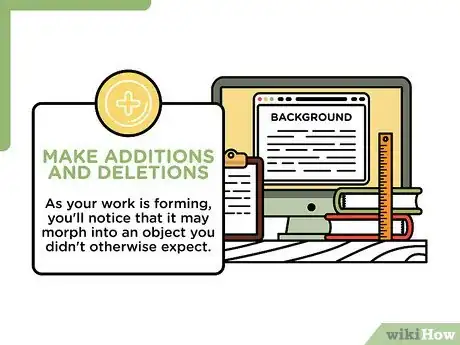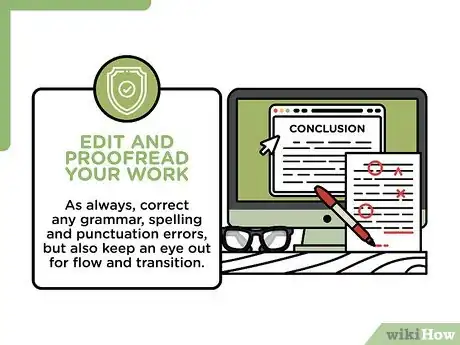wikiHow is a “wiki,” similar to Wikipedia, which means that many of our articles are co-written by multiple authors. To create this article, 23 people, some anonymous, worked to edit and improve it over time.
This article has been viewed 574,628 times.
Learn more...
There are many different kinds of case studies. There are also various uses for writing case studies, from academic research purposes to provision of corporate proof points. There are approximately four types of case studies: illustrative (descriptive of events), exploratory (investigative), cumulative (collective information comparisons) and critical (examine particular subject with cause and effect outcomes).[1] After becoming familiar with the different types and styles of case study instructions and how each applies to your purposes, there are some steps that make writing flow smoothly and ensure the development and delivery of a uniform case study that can be used to prove a point or illustrate accomplishments.
Steps
Getting Started
-
1Determine which case study type, design or style is most suitable to your intended audience. Corporations may choose illustrative case study method to show what has been done for a client; schools, educators and students may select cumulative or critical case study method and legal teams may demonstrate exploratory (investigative) case study method as a way to provide factual evidence.
- Whatever case study method you're employing, your purpose is to thoroughly analyze a situation (or "case") which could reveal factors or information otherwise ignored or unknown. These can be written about companies, whole countries, or even individuals. What's more, these can be written on more abstract things, like programs or practices. Really, if you can dream it, you can write a case study about it.[2]
-
2Determine the topic of your case study. Once you've picked your angle, you need to determine what your research will be about and where it will take place (your case site). What have you talked about in class? Have you caught yourself coming up with questions during your reading?
- Start your research at the library and/or on the Internet to begin delving into a specific problem. Once you've narrowed down your search to a specific problem, find as much about it as you can from a variety of different sources. Look up information in books, journals, DVDs, websites, magazines, newspapers, etc. As you go through each one, take adequate notes so you can find the info later on![2]
Advertisement -
3Search for case studies that have been published on the same or similar subject matter. Talk to your professors, go to the library, surf the web until your bum falls asleep. You don't want to replicate the research that has already been done.
- Find out what has been written before, and read the important articles about your case's situation . When you do this, you may find there is an existing problem that needs solution, or you may find that you have to come up with an interesting idea that might or might not work in your case situation.
- Review sample case studies that are similar in style and scope to get an idea of composition and format, too.
Preparing the Interview
-
1Select participants that you will interview for inclusion in your case study. Experts in a particular field of study or customers that have implemented a tool or service that is the subject of the study will provide the best information.
- Find knowledgeable people to interview. They don't necessarily have to be on your site, but they must be, actively or in the past, directly involved.
- Determine whether you will interview an individual or group of individuals to serve as examples in your case study. It may be beneficial for participants to gather as a group and provide insight collectively. If the study focuses on personal subject matter or medical issues, it may be better to conduct personal interviews.
- Gather as much information as possible about your subjects to ensure that you develop interviews and activities that will result in obtaining the most advantageous information to your study.
-
2Draft a list of interview questions and decide upon how you will conduct your study. This could be via in-person group interviews and activities, personal interviews, or phone interviews. Sometimes, email is an option.
- When you are interviewing people, ask them questions that will help you understand their opinions. I.e., How do you feel about the situation? What can you tell me about how the site (or the situation) developed? What do you think should be different, if anything? You also need to ask questions that will give you facts that might not be available from an article--make your work different and purposeful.
-
3Set up interviews with subject matter experts (account managers in a corporation, clients and customers using applicable tools and services, etc.).
- Make sure all your informants are aware of what you're doing. They need to be fully informed (and signing waivers in certain cases) and your questions need to be appropriate and not controversial.
Obtaining Data
-
1Conduct interviews. Ask the same or similar questions of all subjects involved to ensure that you get different perspectives on a similar subject or service.
- When you ask a question that doesn't let someone answer with a "yes" or a "no" you usually get more information. What you are trying to do is get the person to tell you whatever it is that he or she knows and thinks --even though you don't always know just what that is going to be before you ask the question. Keep your questions open-ended.
- Request data and materials from subjects as applicable to add credibility to your findings and future presentations of your case study. Clients can provide statistics about usage of a new tool or product and participants can provide photos and quotes that show evidence of findings that may support the case.
-
2Collect and analyze all applicable data, including documents, archival records, observations and artifacts. Organize all of your data in the same place to ensure easy access to information and materials while writing the case study.
- You can't include it all. So, you need to think about how to sort through it, take out the excess, and arrange it so that the situation at the case site will be understandable to your readers. Before you can do this, you have to put all the information together where you can see it and analyze what is going on.
-
3Formulate the problem in one or two sentences. As you go through your data, think about how you can put what you've found into a thesis-like statement. What patterns have your subjects brought to light?
- This will allow you to concentrate on what material is the most important. You're bound to receive information from participants that should be included, but solely on the periphery. Organize your material to mirror this.
Writing Your Piece
-
1Develop and write your case study using the data collected throughout the research, interviewing and analysis processes. Include at least four sections in your case study: an introduction, background information explaining why the case study was created, presentation of findings and a conclusion which clearly presents all of the data and references.
- The introduction should very clearly set the stage. In a detective story, the crime happens right at the beginning and the detective has to put together the information to solve it for the rest of the story. In a case, you can start by raising a question. You could quote someone you interviewed.
- Make sure to include background information on your study site, why your interviewees are a good sample, and what makes your problem pressing to give your audience a panoramic view of the issue.[3] After you've clearly stated the problem at hand, of course.[2] Include photos or a video if it would benefit your work to be persuasive and personalized.
- After the reader has all the knowledge needed to understand the problem, present your data. Include customer quotes and data (percentages, awards and findings) if possible to add a personal touch and more credibility to the case presented. Describe for the reader what you learned in your interviews about the problem at this site, how it developed, what solutions have already been proposed and/or tried, and feelings and thoughts of those working or visiting there. You may have to do calculations or extra research yourself to back up any claims.
- At the end of your analysis, you should offer possible solutions, but don't worry about solving the case itself. You may find referring to some interviewees' statements will do the alluding for you. Let the reader leave with a full grasp of the problem, but trying to come up with their own desire to change it.[2] Feel free to leave the reader with a question, forcing them to think for themselves. If you have written a good case, they will have enough information to understand the situation and have a lively class discussion.
-
2Add references and appendices (if any). Just like you would in any other paper, reference your sources. That's why you got credible ones in the first place. And if you have any information that relates to the study but would have interrupted the flow of the body, include it now.
- You may have terms that would be hard for other cultures to understand. If this is the case, include it in the appendix or in a Note for the Instructor.
-
3Make additions and deletions. As your work is forming, you'll notice that it may morph into an object you didn't otherwise expect. If it does so, make additions and deletions as needed. You may find that information you once thought pertinent is no longer. Or vice versa.
- Go over your study section by section, but also as a whole. Each data point needs to fit into both it's place and the entirety of the work. If you can't find an appropriate place for something, stick it in the appendix.
-
4Edit and proofread your work. Now that your paper is formulated, look for minute revisions. As always, correct any grammar, spelling and punctuation errors, but also keep an eye out for flow and transition. Is everything placed and worded as efficiently as possible?
- Have someone else proofread, too. Your mind may have become oblivious to the errors it has seen 100 times. Another set of eyes may also notice content that has been left open-ended or is otherwise confusing.
Community Q&A
-
QuestionWhat is a simple method for writing a case study?
 Pooja SrivastavaCommunity AnswerThe simplest thing would be to identify the situation and key problems. Include them in the introductory section of your case study. Once you have done that, identify how those problems were solved. This will bring you to the next section - Solution - this is the most technical part, in which you have to explain the solution and its components. Once done, figure out the benefits achieved and list them. The concluding remarks can talk about takeaways, future prospects and recommendations.
Pooja SrivastavaCommunity AnswerThe simplest thing would be to identify the situation and key problems. Include them in the introductory section of your case study. Once you have done that, identify how those problems were solved. This will bring you to the next section - Solution - this is the most technical part, in which you have to explain the solution and its components. Once done, figure out the benefits achieved and list them. The concluding remarks can talk about takeaways, future prospects and recommendations. -
QuestionHow do I write a case study on a fraud case in a bank?
 Community AnswerUse primary sources to research the background and events, then write about what happened and why it is important.
Community AnswerUse primary sources to research the background and events, then write about what happened and why it is important. -
QuestionHow can I write a case study on challenges faced by teachers when teaching social studies?
 Community AnswerYou can probably interview a cross-section of teachers teaching social studies, and ask them what challenges they face. Then write a case study presenting your results.
Community AnswerYou can probably interview a cross-section of teachers teaching social studies, and ask them what challenges they face. Then write a case study presenting your results.
References
- ↑ https://writing.colostate.edu/guides/page.cfm?pageid=1290&guideid=60
- ↑ 2.02.12.22.3http://www.essayforum.com/grammar-usage-13/to-write-case-study-366/
- ↑ https://www.universalclass.com/articles/business/the-process-of-writing-a-case-study.htm
- http://writing.colostate.edu/guides/research/casestudy/pop2a.cfm Colorado State University Case Study writing guides
- http://www.hoffmanmarcom.com/casestudy/howtowrite.php Hoffman Marketing and Communications case study overview
About This Article
To write a case study, start with an introduction that defines key terms, outlines the problem your case study addresses, and gives necessary background information. You can also include photos or a video if they will help your work to be more persuasive. Then, present your findings from the case study and explain your methodology, including how you used your data to come to your conclusions. In your conclusion, offer possible solutions or next steps for research, based on your results. To learn how to select participants for your case study, keep reading.



















-Step-17.webp)



















































